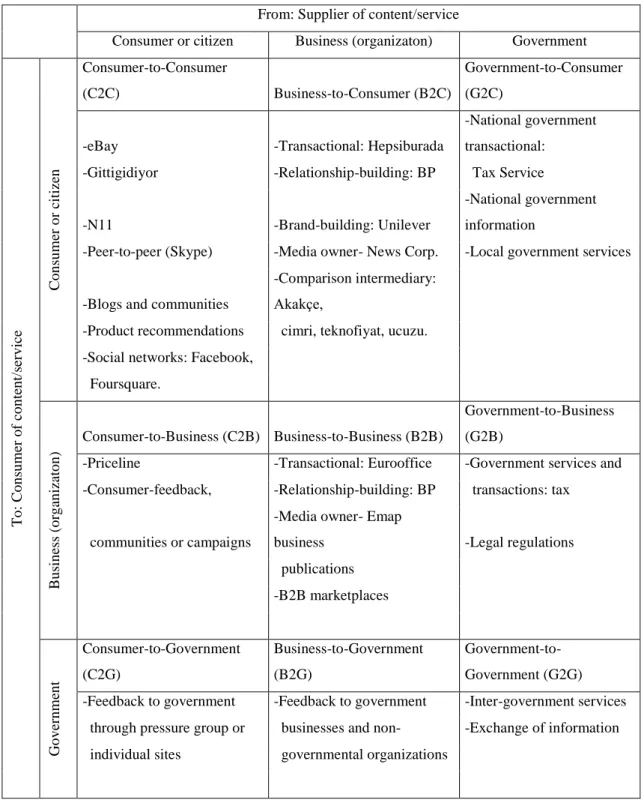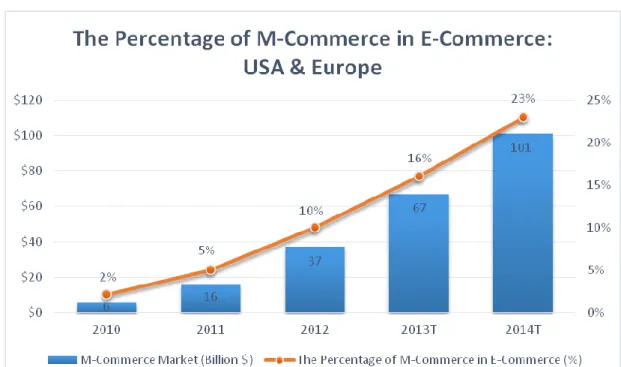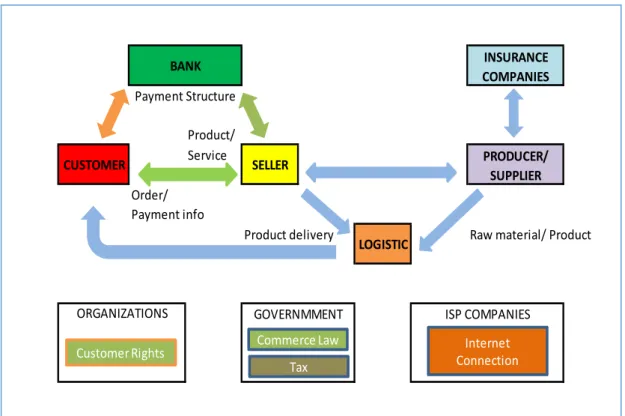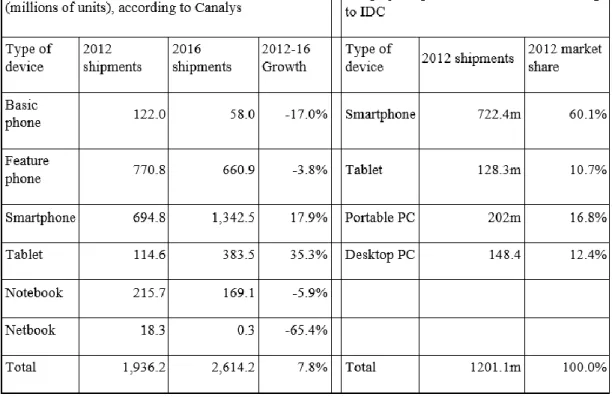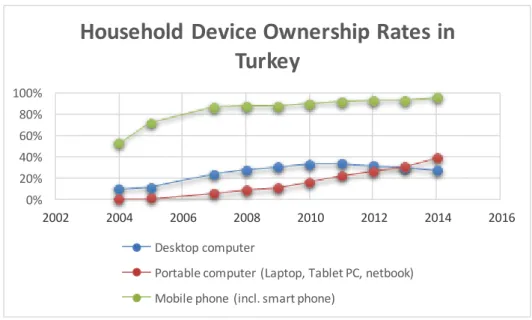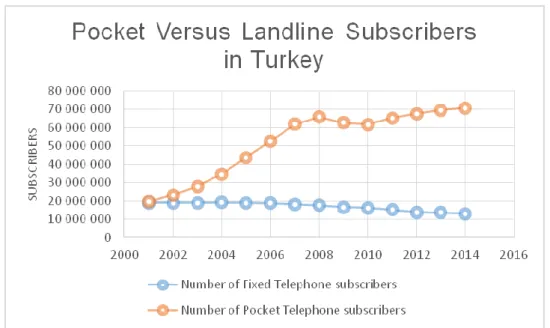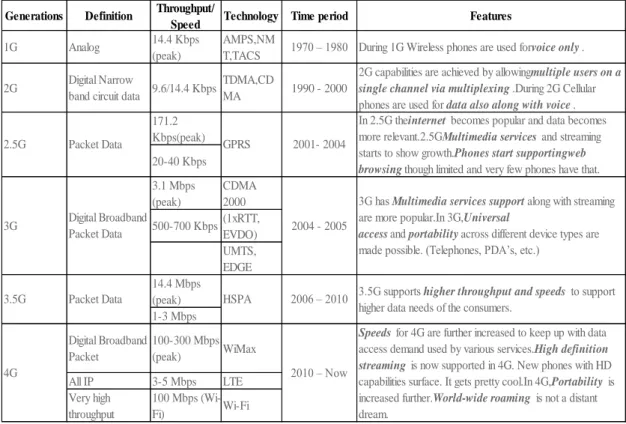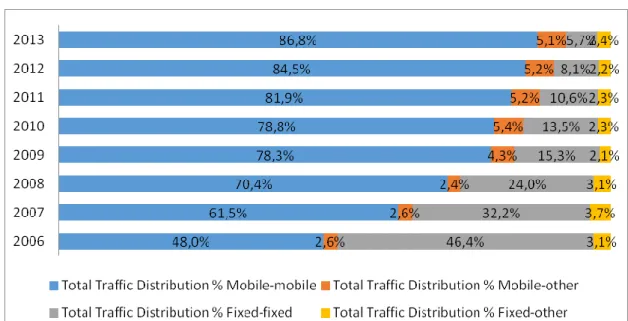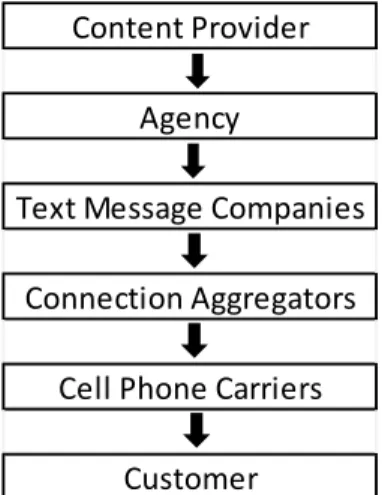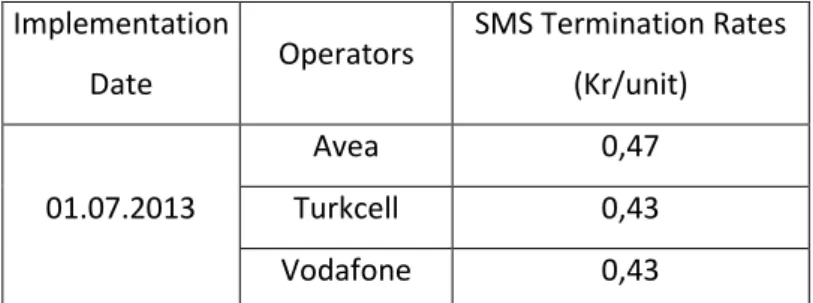T.C.
ISTANBUL AYDIN UNIVERSITY INSTITUTE OF SOCIAL SCIENCES
DETERMINING THE MAIN COMPONENTS OF MOBILE COMMERCE RELATED TO CUSTOMERS' DEMOGRAPHICAL PROPERTIES
THESIS Kemal DEMİR
Department of Business Business Administration Program
T.C.
ISTANBUL AYDIN UNIVERSITY INSTITUTE OF SOCIAL SCIENCES
DETERMINING THE MAIN COMPONENTS OF MOBILE COMMERCE RELATED TO CUSTOMERS' DEMOGRAPHICAL PROPERTIES
M.Sc. THESIS Kemal DEMİR ( Y1212.130010 )
Department of Business Business Administration Program
Thesis Advisor: Assistant Prof. Dr. Tuğba ALTINTAŞ
v
To my family and fiancée,
vii
FOREWORD
When a person visits the new places mostly cannot reach what searching for. If you go touristic places of Istanbul you can miss “the best” or “must see” coffees or restaurants and other activities.
Customers all around and they want to see our products or services. The most important thing about that needs and services how can they intersects. Sometimes needs are so sudden and if the customer doesn’t find it in that moment, they can change their mind another substitute product or service in that moment.
Latest improvements of computers, wireless and mobile devices uses connection to electronic web pages, or some applications and they help the people recognize the products or services and that drive the people make decision about in that very moment and they can try to reach geographically that needs what they want to buy. For example, one of my friend and I wanted to find a restaurant/bar at Kadıköy and he searched that bar from internet for address and also in Google maps for navigation from his smartphone. We find the street but there are full of bars, coffees, restaurants there, we used the navigation to find the right bar. I just realized the technology helping us very much in that important point. It happened before in dry-cleaner searching, a cell phone model that I couldn’t find in tech markets, so I found it on a web store and I ordered from E-commerce web page.
Smartphones, tablets, ultra-books have growing sectors in today’s world and they are effecting the customer’s decisions because of developing mobile internet and Wi-Fi services and location based search applications or web pages. These companies know where you are because of GPS location systems or Wi-Fi areas and they can offer or send you or inform you about their new product or service.
If companies want to reach their customers they must use electronic commerce and mobile commerce in future because this is the powerful tool for marketing their products or services.
December 2015 Kemal DEMİR
ix TABLE OF CONTENT Page TABLE OF CONTENT ... IX ABBREVIATIONS ... XI LIST OF TABLES ... XV LIST OF FIGURES ... XVII ÖZET ... XIX ABSTRACT ... XXI
1. INTRODUCTION ... 1
1.1. Main Purpose of the Study ... 3
1.2. Literature Review ... 3
1.3. Hypotheses ... 8
2. COMMERCE, E-COMMERCE AND M-COMMERCE ... 11
2.1. Commerce ... 11
2.2. E-Commerce ... 11
2.2.1. Definition of e-commerce ... 11
2.2.2. Brief history of e-commerce ... 12
2.2.3. Types of e-commerce transactions: ... 13
2.2.4. E-commerce structure ... 15
2.3. M-Commerce ... 16
2.3.1. Mobility ... 16
2.3.2. M-commerce and m-marketing ... 17
2.3.3. Examining the five elements of mobile marketing ... 18
2.3.4. M-commerce ... 19
2.3.5. Mobile commerce is appropriate for our company? ... 20
3. M-CONSUMERS, M-DEVICES AND NETWORKS ... 23
3.1. M-Consumers ... 23
3.1.1. Identifying mobile consumers ... 23
3.2. M-Devices and Networks ... 25
3.2.1. Exploring the types of mobile devices ... 25
3.2.2. Mobile networks ... 28
4. MOBILE COMMERCE TOOLS ... 37
4.1. Voice ... 37
4.2. Sms ... 39
4.3. Mms ... 41
4.4. Near Field Communication (Nfc) & Bluetooth & Rfid ... 43
4.5. Mobile Wallets ... 44
4.6. Mobile Web Page ... 47
4.7. Mobile Ads and Search Optimized Engine ... 51
x
4.9. Mobile Applications ... 55
4.10. QR Codes ... 59
4.11. Social Media Marketing ... 60
5. CONCEPT OF CONSUMER AND CONSUMER ATTITUDES ... 63
5.1. Concept of Consumer ... 63
5.1.1. Definition of consuming ... 64
5.1.2. Definition of consumer ... 64
5.1.3. Consumer Purchase Process ... 65
5.2. Concept of Consumer Attitudes ... 66
5.2.1. New technology and consumer interaction ... 67
5.2.2. The factors that effects the consumer purchase ... 68
5.2.3. Consumer attitudes ... 71
5.3. Turkish Consumer Profile ... 73
6. DETERMINING THE MAIN COMPONENTS OF MOBILE COMMERCE RELATED TO CUSTOMERS' DEMOGRAPHICAL PROPERTIES RESEARCH ... 83
6.1. Method of the Research ... 83
6.1.1. Problem ... 83
6.1.2. Purpose of research ... 83
6.1.3. Importance of research... 83
6.1.4. Population and Sample ... 84
6.1.5. Assumptions... 84
6.1.6. Limitations ... 84
6.1.7. Collecting the Data ... 84
6.1.8. Analysis of the data... 85
6.2. Findings and Conclusion ... 85
6.2.1. Demographic structure ... 85
6.2.2. Hypotheses testing ... 89
6.3. The Result and Suggestions ... 95
REFERENCES ... 99
APPENDICES ... 105
xi
ABBREVIATIONS
1G : First Generation
2D : Two Dimension
2G : Second Generation
3,5G : Third and Half Generation
3G : Third Generation
4G : Fourth Generation
ACI : Automatic Content Identifier ATM : Automatic Teller Machine
AMPS : Ampere
B2B : Business to Business
B2C : Business to Consumer
BTK : Information and Communication Technologies Authority
C2B : Consumer to Business
C2C : Consumer to Consumer
CD : Compact Disk
CDMA : Code Division Multiple Access
CMI : Consumer Manner Inventory
CRM : Customer Relationship Management
DVD : Digital Video Disk
E-Banking : Electronic Banking E-Commerce : Electronic Commerce
EDGE : Enhanced Data rates in GSM Environment EDI : Electronic Data Interchange
E-Government : Electronic Government E-Mail : Electronic Mail
EMS : Enhanced Message Service E-Payments : Electronic Payments
ETICAD : E-Commerce Web pages and Administers Association EVDO : Enhanced Voice-Data Only
GDP : Gross Domestic Produce
GIF : Graphic Interchange Format
GPRS : General Packet Radio Service GPS : Global Positioning System
GSM : Global System for Mobile Communications
HTML : HyperText Markup Language
xii
ID : Identifier
IP : Internet Protocol
JPEG : Joint Photographic Experts Group KBPS : Kilobits Per Second
Kr : Kuruş
LBS : Location Based Services LED : Light Emitting Diode
LTE : Long Term Evolution
MAP : Mobile Application Part
MBPS : Megabytes per Second
M-Commerce : Mobile Commerce M-Marketing : Mobile Marketing
MMA : Mobile Marketing Association MMS : Multimedia Message Services
MO : Mobile Originated
MP3 : MPEG-1 Audio Layer 3
MP4 : MPEG-4 Part 14
MT : Mobile Terminated
NFC : Near Field Communication NMT : Nordic Mobile Telephones NTT : Nippon Telephone and Telegraph
OECD : The Organization for Economic Co-operation and Development
OS : Operating System
PC : Personal Computer
PDA : Personal Digital Assistant PIN : Personal Identification Number
POS : Point Of Sale
PPC : Pay per Click
QR : Quick Response
RFID : Radio Frequency Identification ROI : Return on Investment
RSS : Really Simple Syndication RTOS : Real-Time Operating System SEO : Search Engine Optimization SIM Card : Subscriber Identity Module Card SMS : Short Message Services
SMSC : Short Message Service Center SPAM : Unsolicited Electronic Messages
SPSS : Statistical Package for the Social Sciences
SSL : Secure Socket Layers
TACS : Total Allowable Catches
TACS : Total Access Communication Systems TDD : Time Division Duplexing
TDMA : Time Division Multiple Access
TD-SCDMA : Time-division Synchronous Code-division Multiple Access
xiii
TUİK : Turkish Statistical Institute
TUKCEV : The Foundation of Consumer and Environment Education
TV : Television
U.S. : United States
UK : United Kingdom
UMTS : Universal Mobile Telecommunications System URL : Uniform Resource Locator
WAP : Wireless Application Protocol Wi-Fi : Wireless Fidelity
WiMAX : Worldwide Interoperability for Microwave Access xDSL : X Digital Subscriber Line
xv
LIST OF TABLES
Page
Table 2.1 : Business or Consumer Models of E-Commerce Transactions………… 14
Table 2.2 : The Percentage of M-Commerce in E-Commerce: USA & Europe…... 15
Table 3.1 : Statistics of Smartphone Usage………... 26
Table 3.2 : Worldwide Mobile Device Shipments Table……….. 27
Table 3.3 : Household Device Ownership Rates in Turkey……….. 28
Table 3.4 : Pocket Versus Landline Subscribers in Turkey……….. 29
Table 3.5 : Mobile Networks Comparison Table……….. 32
Table 4.1 : Total Traffic Volume……….. 38
Table 4.2 : Total Traffic Distribution……… 38
Table 4.3 : Calling Price Per Minute………. 39
Table 4.4 : Mobile SMS Usage in Turkey……… 40
Table 4.5 : SMS Call Termination Rates……….. 41
Table 4.6 : Mobile SMS and MMS Usage in Turkey……… 42
Table 4.7 : Proximity Mobile Payment Transaction Value and Change Percent. 44 Table 4.8 : Desktop, Mobile and Tablet Usage Comparison Globally………. 48
Table 4.9 : Top Desktop & Mobile Browsers in Turkey from 2010 to 2014…… 51
Table 4.10 : Websites Visited via Smartphone………. 52
Table 4.11:Top 5 Mobile Search Engines Usage Percent Worldwide 2008-2014. 53 Table 4.12 : Time Spent With the Internet by Device in the USA……… 56
Table 4.13 : Penetration of Social Networks in Turkey as of Q2 2014……… 61
Table 5.1 : Population of Turkey……….. 74
Table 5.2 : Mobile and Internet Subscribers in Turkey……… 74
Table 5.3 : Civil Status of Turkey………. 75
Table 5.4 : Purchasing Power Parity of Turkey……… 75
Table 5.5 : Education Attainment of Turkey……… 76
Table 5.6 : Debit, Credit Card and POS Statistics in Turkey………... 77
Table 5.7 : Credit Card Payments on Internet in Turkey……….. 77
Table 6.1 : Demographic Characteristics……….. 86
Table 6.2 : Descriptive Statistics of Survey Questions………. 88
Table 6.3 : Gender T-Test Results……… 89
Table 6.4 : Age ANOVA Results………. 90
Table 6.5 : Marital Status T-Test Results………. 91
Table 6.6 : Education Status ANOVA Results……… 92
Table 6.7 : Employment Status ANOVA Results……… 93
Table 6.8 : Monthly Income Status ANOVA Results……….. 94
xvii
LIST OF FIGURES
Page Figure 2.1 : E-Commerce Structure………. 16 Figure 4.1 : Text Message Industry Players………... 40
xix
TÜKETİCİLERİN DEMOGRAFİK ÖZELLİKLERİ İLE İLGİLİ MOBİL TİCARET ANA BİLEŞENLERİNİN BELİRLENMESİ
ÖZET
Teknolojik gelişmeler sayesinde zamanla ticaret değişmiştir. Şimdi mobil çağa ulaştık ve bizler her şeyi cebimiz kadar olan bilgisayar benzeri mobil cihazlarımızla yapabiliyoruz. Ürün ve satıcıların çeşitliliği müşteriler için büyük ve karmaşık alışveriş çevresi oluşturmaktadır. Bunun gibi pazarlar satıcıları müşterilerinin isteklerini yakından anlamaya ve onları kendilerine uygun ürün ve hizmetlere yönlendirmeye itmiştir.
Mobil ticaret müşterilere mobil cihazları aracılığıyla ulaşmak ve yeni bağlantılar oluşturmak için yeni ve etkili bir kanaldır. Elektronik ticaretin avantajları mobil ticaret ile yeni bir aşamaya taşınmıştır. Bu yeni aşamada ticaret ve iletişim kanunları, altyapı, güvenlik, tüketici alışkanlıkları ve tutumları hakkında kat edeceği yol vardır. Bu araştırma müşterilerin demografik özelliklerinin mobil ticaret ana bileşenleri ile ilişkisini hedef almaktadır. Sonuç ve öneriler bölümünde, anket sonuçları değerlendirilmiş ve demografik özelliklerin mobil ticarete olan ilişkisi irdelenmiştir. Anahtar Kelimeler : M-Ticaret, Tüketicilerin Tutumları, Demografik Özellikler,
xxi
DETERMINING THE MAIN COMPONENTS OF MOBILE COMMERCE RELATED TO CUSTOMERS’ DEMOGRAPHICAL PROPERTIES
ABSTRACT
The commerce changed in time according to the technological advances. Now we reached mobile age, and we can do every kind of things with our pocket size computer like mobile devices. The variety of products and sellers creates huge and complex shopping environment for the consumers. In such market pushed to the sellers understand their consumer’s wants closely and guide them to suitable products and services.
Mobile commerce is a new and effective channel for reaching to the consumers and create new connections by their mobile devices. The advantages of electronic commerce moved on a new stage by mobile commerce. This new stage has way to go about trade and communication laws, infrastructure, security, consumer habits and attitudes.
This research aims at the relationship between customers’ demographical properties and mobile commerce main components. In the section of the result and suggestions, the survey results and the demographical properties and mobile commerce relationship are evaluated.
Keywords : M-Commerce, Consumer Attitudes, Demographical Proporties, Mobile
1
1. INTRODUCTION
Technology is become the nucleus of the productivity of market and commerce structures. Rise of technological improvements creates benefits for companies as well as consumers. Advances in technology and rapidly changing internet and mobile devices, connectivity between the persons, business and e-commerce advertising made a huge impact activities of countries and companies.
Market structures changed during the last decades. Today most of the companies using digital marketing system with their real market to reach their buyers/consumers. Electronic commerce removed the borders of the countries and companies started rivalry between them not only national but also internationally. Selling the products and services to customers are getting easy with E-commerce web pages with 7/24 online internet shopping. This competition improved the marketing skills of companies to succeed and save their market share from competitors.
Mobile phone usage rising and mobile companies growing with bigger profits. Recent years internet connected portable devices are highly increased. Especially Smartphone users exploded very much. Smartphones are today giving the experience of mobile computer, telephone, TV, movie player, camera, music player, scanner, gaming, navigation with the help high speed mobile internet connectivity. Mobile industries thrive fast nowadays. The companies must have followed these trends if they want to get success at the business.
Mobile devices becoming more common than personal computers around the world. Mobile devices allows the individuals to access the internet when they are moving even far distances have no market infrastructure exist. Mobile is a new and popular medium among people in the world.
Mobile industry created a new market and customers have new attitudes for this market. Attitudes of the customers are the dynamic side of the Mobile commerce. Managers must know and understand their target customers and give them nice
2
service and products by arranging commerce ingredients. Information age culture changed the costumers are more active on the internet and with this companies watching the visitors and collecting data and identifying their needs. Why the customers choosing one product to another and what is the main mechanism behind to buying a product must be understand by the companies. This is the main purpose of the examine consumer’s attitudes.
Mobile commerce has a strategic position for company’s success. I want to study that topic because I saw that smartphones as a revolutionary device for future of the world and they become inevitably a part of our lives. I want to imply the mobile commerce effectiveness and how that contribute and accelerate the company’s success.
The first episode of the study introduction, in this episode main topic, main purpose of the study, literature reviews and the hypotheses are explained.
The second episode of the study defines concepts of commerce, e-commerce and mobile commerce and how these concepts are improved in time. In this episode, mentioned why the companies must follow the trends in commerce for their success. The third episode of the study defined mobile consumers, mobile devices and mobile networks. In this episode, mobile consumer characteristics explained and how they changed in time with today’s new type of connection speeds. Besides that, in this episode explained variety of wireless connections between consumers and corporations create new ways to reach their consumers.
The fourth episode of the study examined mobile commerce tools that help to create connection between consumers and sellers, improve consumer experience and maintain the advertising, marketing, commerce, payments, after sale relationship activities by these powerful tools.
The fifth episode of the study defined the concept of consuming, consumer and stages of the purchase process and focused on new technology and consumer interaction and factors that affect the consumer attitudes through mobile commerce activities. Turkish consumer profile outlined at the end of this part of the thesis.
3
The sixth episode of the study will be the last section, in this section mentioned method of research and the other details about thesis study and survey. The results of survey about customers’ demographical properties evaluated and according to the results of the survey suggestions explained for the purpose of thesis.
1.1. Main Purpose of the Study
The study focuses on the determining the main components of mobile commerce related to customers’ demographical properties in Istanbul, Turkey by making a survey questioner. In the study main purpose is find out, customers’ demographic properties have a significant relationship on mobile commerce.
1.2. Literature Review
There are plenty of studies about consumer attitudes and mobile commerce. These studies tried to find out the variables which properties effects mobile commerce and what are the consumer’s attitudes for mobile commerce.
Nemet’s research about the evolution of M-Commerce concludes that in order for m-commerce to become a truly viable customer channel, the infrastructure to support instantaneous interactions and the delivery of real-time, personalized information must be put in place. Collecting feedback from early experimenters will also be critical in defining the value proposition of m-commerce offerings to consumers in the future. In the meantime, companies should focus narrowly on taking advantage of the unique strengths of the channel, and meeting clearly defined needs for targeted, time-sensitive, and location-specific information. (Nemet, 2001, p.57)
Gribbins’s research about investigation into employees’ acceptance of integrating m-commerce into organizational process results shows that, employees at one Fortune 100 company indicated that employees have an interest in having on-demand mobile access to their applications. The findings indicate that technology-related and individual-related constructs alone do not adequately explain the variance in attitudes and usage behavior. Also additional factors such as environment in which technologies are employed effects the behaviors. Identifying these factors and addressing related concerns during the technology development process, can reduce
4
some of the uncertainty associated with usage and can strengthen the solutions’ potential for success (Gribbins et al., 2003).
Wu’s research about what drives mobile commerce results shows that, M-commerce is still in its infancy, mobile devices or relative applications are still under development and in progress, yet, it is pointed out that cost is the least significant determinant in the initial M-commerce context on any factor but perceived ease of use. Furthermore, M-commerce has limited types of applications and that will cause insufficient understanding of M-commerce and its applications will lower consumer intention to use it (Wu et al., 2004).
Tsang, Ho and Liang’s research about attitudes towards Mobile advertising showed that respondents held negative attitudes about receiving mobile ads. Their attitudes were favorable if advertisements were sent with permission. This implies that permission-based advertising may become a major mechanism in the mobile environment in the future. The respondents were more willing to accept incentive-based mobile advertising. Overall, it is clear that mobile advertising is going to be the future trend (Tsang et al., 2004)
Sarısakal published a paper about mobile commerce, developing technology of mobile communication made mobile tools secure for commerce and payments but investments are not enough for mobile commerce world yet (Sarısakal, 2005).
Hsieh published a paper about mobile commerce, assessing new business opportunities, it is concluded the future of the M-Commerce is very optimistic. Global wireless subscribers are expected to reach between 1,5-2 billion by the year 2010. There will be more wireless Internet users than fixed line users, and there will be more mobile phones than fixed line phones by 2003. Mobile communication will be an essential leg of the information infrastructure to connect people to the information sphere while on the move. M-Commerce can transform people’s lifestyle with unique, personalized and location based services. People will be able to order movie tickets on the go, find directions instantaneously, use the phone to pay for coke from vending machines, access the internet, send email while relaxing on the beach, and have access to the office scheduler from anywhere, anytime ( Hsieh, 2007).
5
Barutçu’s research about Consumers’ attitudes towards Mobile Marketing and Mobile Commerce in Consumer Markets in Turkey results shows that, all GSM operators announce the launch of new mobile services and the B2C mobile commerce and mobile marketing will be obviously becoming more popular in Turkey. It is too early to say whether mobile commerce and mobile marketing services are accepted or not in Turkey, the findings of the research conducted Turkish mobile phone users suggest that mobile phone users have positive attitudes towards mobile marketing tools except for mobile shopping (Barutçu, 2008).
The research made by Kini in Chile country results shows that, it was observed that Chileans are highly network ready and are adept at downloading many ring tones per year into their cell phones. This would have usually indicated their propensity to use mobile devices to conduct M-Commerce. One can conclude that there is a high level of usage of e-Commerce among this respondent group in Chile. Respondents in the study are familiar with the technology and applications, yet have not transformed themselves to the appreciative and innovative users of mobile technology to leverage the everywhere and always available feature of the mobile technology (Kini, 2009). Yamamoto’s research about the mobilized marketing and the consumer concluded that in general, the electronic procurement infrastructure in Turkey is developing but still insufficient. To date, the most significant problem is the security problem, and the most advanced area can be seen as the financial area. However, security problems weaken the strengths of the financial infrastructure (Yamamoto, 2010, p.260). According to the research Safeena about customer’s adoption of Mobile-Commerce results shows that perceived usefulness, perceived ease of use, subjective norm, consumer awareness and perceived risk are the important determinants of mobile banking adoption. These factors have a strong positive effect on acceptance of mobile banking (Safeena et al., 2011).
Turan’s research about the factors that determines consumers behaviors about internet shopping in Turkey results shows that, internet shopping is depends on the consumer’s aim for purchase and their faiths, action and behavioral controls. Furthermore, consumer actions also effects by their near individual’s ideas that is important for them (Turan, 2011).
6
According to the survey report of comScore shows that, in United States of America %38 of the smartphone users wishes to make all kind of shopping on their mobile devices (ComScore, 2011)
According the research Venkatesh about consumer acceptance and use of information technology results shows that consumers use of technology the effects of hedonic motivation, price value, and habit are complex. First, the impact of hedonic motivation on behavioral intention is moderated by age, gender and experience. Second, the effect of price value on behavioral intention is moderated by age and gender. Finally, habit has both direct and mediated effects on technology use and these effects are moderated by individual differences (Venkatesh et al., 2012)
Khansa, Zobel and Goicochea’s research about Mobile commerce Innovations showed that it is apparent that mobile devices have changed e-commerce as we know it by empowering consumers to make better decisions and by supporting them, through the use of innovative technologies and services, in the process of creating value for themselves and for others. Not only has this helped to create more efficient and enjoyable shopping experiences for consumers, but it has also allowed retailers to improve their productivity, reduce their costs, and do a better job of providing customers with products that meet their needs and expectations. As the technical infrastructure and the business environment continue to evolve, it is certain that the realm of m-commerce will continue to generate new innovations that will ultimately make a significant impact on our society (Khansa et al., 2012)
According the research Amoroso about building a research mobile for mobile wallet consumer adoption, the case of mobile Suica in Japan results shows that technology-based payment solutions hinges on addressing the needs, perceived or real, of consumers whose adoption will determine whether any specific mobile payment systems becomes a standard. Japan is at the forefront of such technology and a number of domestic companies have been successfully developing and integrating mobile payments for some time. Also it is pointed out in the study, cultural factors play an important role in the adoption of the mobile wallet. In Japan, there is a technology push culture, where large organizations in the ecosystem, such as Sony, have technology advances. Once developed, these technologies are introduced into mobile devices and consumers use these innovations (Amoroso et al., 2012).
7
Pew Internet and Elon University report about the future of the money in a mobile age shows that, mobile wallets will be in use broadly soon. %65 of the survey attendants wishes that they can able to do every payment by their mobile wallets in 10 years. Google wallet and similar applications are making credit cards mobile cards so it is considering after 2020 such smartphone applications will replace to money (Smith et al., 2012)
According to the report of comScore mobile consumers are using their mobile devices for reaching detailed information and adding shopping richness to their shopping experience. In the survey they pointed out %62 of Spanish and American users using their mobile devices for reaching information they needed. According the examined mobile data between the years 2011-2012, %35 of the French mobile users sharing their photo shots with their friends when they are visited a shopping store, %31 of them is making research by their mobile devices. According to another research İve pointed out; %78 of the mobile users who visiting physical shops are using their smartphones for searching nearest shops, %63 of them is comparing the prices in the internet. In the research, %68 of the tablet users are making researches before buying, %53 of them is reading the product comments before the purchases (Sütcü, et al. 2013, p.58-59)
The research made by Xu about M-commerce development in China results shows that, people from different age groups have different perceptions for m-commerce development, users with different backgrounds might view m-commerce development differently, user’s economic level has impact on their exposure to advanced m-commerce development and applications. People with higher economic status tend to have more opportunity to use more advanced m-commerce applications, probably because these advanced applications are normally more expensive also gender and education level have no significant impact on user’s perceptions of m-commerce development (Xu, 2013).
Bal, research about technology, youth and mobile life and cell phone usage attitudes on daily life points out cell phones are voice and written communication, internet, social media applications, camera, satellite connection, maps and lots of other features in its little body become social and cultural phenomenon. In society almost at every age individuals addicted to these devices inevitably. According to the survey average aged 21 years old 1175 individuals are using mostly cell phones for 7 years.
8
That shows most of the individuals are met with the cell phone technology in their early ages. The survey shows that the attendants talking with their phones daily 40 minutes. Also results shows women are talking and sending SMS more than men with their cell phones (Bal, 2014, p.223-225).
Gümüş research focused how internet ads affect consumer’s purchase behaviors and made a survey in Istanbul with 126 attendants. In the survey %77 attendants were employees. According to the survey results %74 of persons are effected by internet ads to make purchases. %32 of the persons preferred to get information by reading comments about sales shop from internet before or after purchase. %93 of the persons feels acquaintance when they saw the products which they saw in the internet ads before (Gümüş et al., 2014).
The research made by Mishra in India country results shows that, attitude and perceived controls are significantly related with intention. Indians spend a lot time with mobile phones and they find it to be very important device in their day to day life, generally they perceive many benefits from mobile phones apart from communication. As a result, they may be showing high value for attitude towards m-commerce too. Furthermore, if marketers are able to create positive attitude towards m-commerce in consumers mind it will lead to higher intention and finally adoption behavior (Mishra, 2014).
1.3. Hypotheses
This study aims at try to find out significant relationships between consumers’ demographic properties on mobile commerce by testing the hypotheses. For testing this purpose the hypotheses are listed below:
H1: There is a relationship between gender and attitudes on mobile commerce. H2: There is a relationship between age and attitudes on mobile commerce.
H3: There is a relationship between marital status and attitudes on mobile commerce. H4: There is a relationship between education and attitudes on mobile commerce. H5: There is a relationship between employment and attitudes on mobile commerce. H6: There is a relationship between monthly income and attitudes on mobile commerce.
9
H7: There is a relationship between monthly saving ratio and attitudes on mobile commerce.
11
2. COMMERCE, E-COMMERCE AND M-COMMERCE
2.1. Commerce
Commerce defines as, exchange of goods or services for money or in kind, usually on a scale large enough to require transportation from place to place or across city, state, or national boundaries (Business Dictionary, 2014).
In time, with the digital revolution everything changing with this digital age as commerce become E-Commerce these days. In this thesis before to take a look at the M-Commerce, I wanted to start with one step backward from the M-Commerce.
2.2. E-Commerce
2.2.1. Definition of e-commerce
The Organization for Economic Co-operation and Development (OECD) defines the E-commerce: “An e-commerce transaction is the sale or purchase of goods or services, conducted over computer networks by methods specifically designed for the purpose of receiving or placing of orders. The goods or services are ordered by those methods, but the payment and the ultimate delivery of the goods or services do not have to be conducted online. An e-commerce transaction can be between enterprises, households, individuals, governments, and other public or private organizations. To be included are orders made over the web, extranet or electronic data interchange. The type is defined by the method of placing the order. To be excluded are orders made by telephone calls, facsimile or manually typed e-mail.” (OECD Glossary, 2013).
Kalakota and Whinston refer to a range of different perspectives for E-commerce (Chaffey, 2011, p.10):
1. A communications perspective – the delivery of information, products or services or payment by electronic means.
12
2. A business process perspective – the application of technology towards the automation of business transactions and workflows.
3. A service perspective – enabling cost cutting at the same time as increasing the speed and quality of service delivery.
4. An online perspective – the buying and selling of products and information online.
E-commerce is facilitated by a range of digital technologies that enable electronic communications. These technologies include Internet communications through web sites and e-mail as well as other digital media such as wireless or mobile and media for delivering digital television such as cable and satellite (Chaffey, 2011, p.11). 2.2.2. Brief history of e-commerce
E-commerce was introduced 40 years ago and, to this day, continues to grow with new technologies, innovations, and thousands of businesses entering the online market each year. The convenience, safety, and user experience of ecommerce has improved exponentially since its inception in the 1970’s.
1960-1982: Paving the way for electric commerce was the development of the Electronic Data Interchange (EDI). EDI replaced traditional mailing and faxing of documents with a digital transfer of data from one computer to another. Michael Aldrich, an English inventor, innovator and entrepreneur is credited with developing the predecessor to online shopping. In 1979 Aldrich connected a television set to a transaction processing computer with a telephone line and created what he coined, “teleshopping,” meaning shopping at a distance.
1982-1990: It was apparent from the beginning that B2B online shopping would be commercially lucrative but B2C would not be successful until the later widespread use of PC’s and the World Wide Web, also known as, the Internet.
90’s to Present: In 1990 Tim Berners Lee, along with his friend Robert Cailliau, published a proposal to build a “Hypertext project” called, “WorldWideWeb.” The inspiration for this project was modeled after the Dynatex SGML reader licensed by CERN. Berner’s Lee decided he would take on the task of marrying hypertext to the Internet, in doing that, the process led to him developing URL, HTML and HTTP. National Science Foundation lifted its restrictions on commercial use of the NET in 1991, the Internet and online shopping saw remarkable growth. From the beginning,
13
there were many hesitations and concerns with online shopping but the development of a security protocol - the Secure Socket Layers (SSL) - encryption certificate by Netscape in 1994 provided a safe means to transmit data over the Internet. The mid-nineties to 2000’s saw major advancements in the commercial use of the Internet. Amazon, launched in 1995 as an online bookstore. Currently, Amazon offers not only books but DVDs, CDs, MP3 downloads, computer software, video games, electronics, apparel, furniture, food, and toys. In 2001, Amazon.com launched its first mobile commerce site.
Global ecommerce company, PayPal, began its services in 1998 and currently operates in 190 markets.Currently, PayPal manages more than 232 million accounts, more than 100 million of them active.
The growing use of the Internet, tablet devices, and smart phones coupled with larger consumer confidence will see that ecommerce will continue to evolve and expand. With mobile commerce gaining speed, more users are purchasing from the palm of their hand (Miva, 2011).
2.2.3. Types of e-commerce transactions:
1. Business to customer (B2C) transactions between an organization and consumers. 2. Business to business (B2B) transactions between an organization and other
organizations
3. Consumer to consumer (C2C) transactions between consumers but generally provided by web page.
4. Consumer to business (C2B) Consumers offers something to the business owners. 5. The diagram also includes government and public services organizations which
14
Table 2.1 : Business or Consumer Models of E-Commerce Transactions
From: Supplier of content/service
Consumer or citizen Business (organizaton) Government
T o : Co n su m er o f co n te n t/s er v ice C o n su m er o r citizen Consumer-to-Consumer (C2C) Business-to-Consumer (B2C) Government-to-Consumer (G2C)
-eBay -Transactional: Hepsiburada
-National government transactional:
-Gittigidiyor -Relationship-building: BP Tax Service
-N11 -Brand-building: Unilever
-National government information
-Peer-to-peer (Skype) -Media owner- News Corp. -Local government services
-Blogs and communities
-Comparison intermediary:
Akakçe,
-Product recommendations cimri, teknofiyat, ucuzu.
-Social networks: Facebook,
Foursquare. B u sin ess ( o rg an izato n ) Consumer-to-Business (C2B) Business-to-Business (B2B) Government-to-Business (G2B)
-Priceline -Transactional: Eurooffice -Government services and -Consumer-feedback, -Relationship-building: BP transactions: tax
communities or campaigns
-Media owner- Emap
business -Legal regulations
publications -B2B marketplaces Go v er n m en t Consumer-to-Government (C2G) Business-to-Government (B2G) Government-to-Government (G2G) -Feedback to government -Feedback to government -Inter-government services through pressure group or businesses and non- -Exchange of information individual sites governmental organizations
This table shows the transaction types of e-commerce between the commerce members (Chaffey, 2009, p.26).
15
Table 2.2 : The Percentage of M-Commerce in E-Commerce: USA & Europe
According to the study about E-commerce shows that the M-commerce percentages are raising if we compare it with E-commerce sales in United States and Europe. Mobile Commerce sales reached 6 Billion $ in 2010, which means %2.2 of the E-Commerce sales, 37 Billion $ in 2012 (%10 of the E-E-Commerce Sales) and M-commerce estimated 101 Billion $ sales in 2014 (%23 of the E-Commerce Sales). It is also estimated in the report United States of America’s mobile sales are risen %56 in last year, it is projecting that mobile commerce sales rise %25 of the E-Commerce sales in 2017 (Arfa, 2014, p.96)
2.2.4. E-commerce structure
E-commerce is structured in “virtual shops” that offer products and services online. Even “virtual shopping malls” have been created with lots of shops offering every kind of products for the sale. The most known way of Ecommerce is the B2C. E-commerce which consists in that online retailers manage for reaching to individual consumers through the website.
16 Product/
Service
Order/ Payment info
Product delivery Raw material/ Product Payment Structure INSURANCE COMPANIES PRODUCER/ SUPPLIER LOGISTIC ORGANIZATIONS SELLER CUSTOMER BANK ISP COMPANIES GOVERNMMENT
Customer Rights Commerce Law Tax
Internet Connection
Figure 2.1 : E-Commerce Structure
In the figure above shows all the components that participate in the online purchasing and how they are structured. Today, this structure changed more complex structure with the mobile devices participation.
2.3. M-Commerce
2.3.1. Mobility
Mobility, is the technological solutions for the purpose needed by individuals that to reach the valuable information in time and make process over it to reach their aims. With this mobility giving us safe and real time information access or enter data from multiple sources at the same time. Also via mobility decision making process become faster and as a consequence productivity increasing. Mobility helping the information serving to the workers, rising the determination and profits, decreasing the costs of administration and its complexity and also that improvement of communication activities rising the customer satisfaction by serving their demands and providing service them on time with right answers (Özgüven, 2013, p.7).
17
Mobility changed the shopping ways and habits by also changed the communication, reaching the news and information, inspired to the entertainment world. This term, removed the borders of time and place.
Mobility term changing at the same time parallel to thrive of the human and its expanding the borders. Canalys declared the worldwide smartphone selling numbers in 2011 488 millions sold at the same time 415 million computers are sold. In 2011, worldwide 63,2 million tablet sold and the rise rate of sold was %274. In Turkey the year 2010 smartphone market share was %15 but that percentage raised to %24 at the year 2011. 13 millions of smartphone sold in Turkey in 2011 and that number shouldn’t be underestimated. The devices that compatible with the mobility rising increasingly, we can say that it’s spreading and rising more and more. The people who uses smartphones and tablets realized the utilities and they cannot use other devices after that experiences. The new devices according to the improvements of the technology pushing to the changes of former ones. As a consequence demand is rising that kind of devices and at the same time mobility reaching a different point (Özgüven, 2013, p.9-10).
2.3.2. M-commerce and m-marketing
There are not an exactly definition for mobile commerce. Every source are making slightly different that other ones (Mobileinfo, 2001).
M-Commerce for Nemet, the customer use of mobile devices to transmit the buying decisions to make transactions with others” (Nemet, 2001, p.7)
M-Commerce is for mobilecity, any digital transaction or information interaction made by using a mobile device and mobile networks that leads to transfer of real or perceived value in exchange for information, services or products (Mobilecity, 2014).
Mobile marketing, some of practices that enable businesses to transmit each other and touch with their crowd in an interactive and similar way through every mobile device or network (MMA, 2014).
As we understand from the definitions, mobile commerce, reaching to the customers by using remotely and wireless communication ways for common devices like cell phones, pocket pc’s and the other devices, then customers or untethered customers
18
reached by the company makes own activities such as product, service, idea, process and the other persons.
Mobile marketing in last 5 years becoming a strong weapon in the hands of who makes commercials for the a crowd of people whose changed their aim and intensity of using media such TV, newspaper, radio etc. to Digital places (intensely mobile and internet usage). But thrive of this aim changer didn’t happened like companies aimed for the mobile marketing, because after crowd spent more time and money on their mobile communications then companies followed them. For example, it’s impossible to catch the young population by traditional media. They are using social media, instant messaging services, smartphone applications and mobile internet pages these places where they are now. The rise of the mobile commerce happened as a consequence of the customers selections. Because of that reasons we shouldn’t look that new communication way like a discovery or an invention, we need to see that it’s a playground for companies to attract their customers (Arslan et al., 2012, p.25-26).
2.3.3. Examining the five elements of mobile marketing
Organizations: Organization is an establishment who buys sells products offerings and services and support the markets by these actions. Mobile commerce can implement every kind of business to make it more effective.
Practices: Practices contains lots of ways they are commerce activities making agreements, advertising, managing customer service and loyalty of consumers. In other words they are the all activities that an organization needs to make in active business. All of these practices can be attach to the mobile commerce.
Engagement: Engagement means the process the company and consumers interactions to reach them support them taking attention them feedback each other. Mobile commerce is making such engagement easier for both sides.
Relevancy: Mobile activities can give us info about person’s location and time etc. if someone searching a product or service in a city the search engines helps to show nearest and open shop them what they are searching for. Mobile commerce is effective about finding relevant things for customers.
19
Mobile devices and networks: There are plenty of devices or networks but there are common points that companies can execute their commerce activities by using these mobile networks and mobile devices. (Becker et al., 2010, p.10-11)
2.3.4. M-commerce
Nowadays we are in the middle of the tech revolution is bigger than TV or PC. Now businessman challenging with what they will do with this mobile technology to serve the consumers effective way. The new mobile market will change everything we get accustomed (Martin, 2011, p.15).
During the information era customers has acquainted three kinds of screens, these are caused very important developments on commerce and marketing technique and the way they reach the customers. And every era awarded a prize who they are conformed to these screens.
The first screen, television, revolutionized the way sellers’ interacted customers, TV allowed them to make their messages reach millions of people. Families watched that same programming and all were exposed to the same commercial messages. In the beginning of 1990’s the main media instruments was television, radio, printed media, outdoor TV and cinemas coming to the mind.
The second screen, the PCs, advanced interaction; PCs allowed firms to reach and sell to new consumers easily and gain feedback about their products and services quickly. PCs made the commerce more interactively the consumers are more participated into the sell and buying activities besides they can reach information from long distances.
The third screen, we can say the Smartphone, giving a possibility to the consumers to create a direct way of communication with each other with easiness and to share their experiences every time and everywhere. The smartphones created technological and behavioral aspects will revolutionize the markets in long time (Martin, 2011, 15-17). There are the reasons of digital services why improving so fast (Gümüş et al., 2014, p.11);
1. Microprocessors developed rapidly and parallel to this Personal Computers, Mobile Phones, PDAs, personal music players, gaming devices and the other electronic devices provided to the customers in low prices,
20
2. Digital storage systems provided digital data and contents can be served in form of compressed formats (for example: JPEG, MP3, MP4) maintained rich media video, picture , fun and other contents easily reached to the customers,
3. Because of the developments of telecommunication digital data connected with fiber optic networks and wireless connection provided to the customers in low prices,
4. The hardware and software which are improved to prepare and share the digital rich media contents become easy for the companies.
New digital mobility creating new consumers who wants more than traditional communications of the companies. New consumers wants to see new products in their active mobile devices and reach what they want about every product and service. They are in control, and marketers will be challenged to serve their needs and to interact with them in significant ways.
Mobile is a game changer: m-commerce is not just about using the phone to pay for something, it is about changing better the whole purchasing way. With mobile, commerce become hyper local that concerned with a specific, targeted geographic area. Serving the specific needs of users when and where those needs arise is what m-commerce is all about.
Mobile marketing involves much more than providing coupons and discounts. It’s about committing to interactions with consumers and taking them to the new mobile environment that defines future (Martin, 2011, p.17).
According to the ETICAD (E-Commerce Web pages and Administers Association), in the world approximately 300 million of smart phone users exist. Commerce could also provide by mobile devices. It is suggested in the meeting of 2014 Q4, within the next 5 years Smartphone purchases will be equal to the amount of the purchases made by credit cards (ETICAD, 2014).
2.3.5. Mobile commerce is appropriate for our company?
Mobile marketing’s start point shouldn’t be only making a web or mobile page. Instead of that we should ask ourselves “Is Mobile Marketing is appropriate for my business?”
21
1. Do you need new customers?
2. Do you want your customers visit you more often? 3. Do you want to rise your profits?
4. Do you want to reach more mass groups of people? 5. Do you want to differentiate your brand?
6. Do you want to rise your Return on investment (ROI)?
7. Do you want to your customers spend more money when they shopping from your company?
8. Are you searching new distribution channels? 9. Do you want to rise your market share?
10. Do you want to be in front of your customers 7/24?
Here in this list at least one or a few line is interested for any company, that shows us who doesn’t want to improve the company’s profits (Hopkins et al., 2013, p.21).
23
3. M-CONSUMERS, M-DEVICES AND NETWORKS
3.1. M-Consumers
3.1.1. Identifying mobile consumers
There’s no difference of wishes between mobile consumers and general crowd of people. In fact, if we take into account the prevalence of the mobile devices, the aim must be general crowd of the people.
In time customers using their phones more and more for other purposes, some main marketing methods are becoming outdated. Companies should provide better ways to reach customers.
There’s some difficulty to create a “collective excitement” for the people who they are have same purposes and same wishes at the same time. Sport activities, politic meetings, concerts, ceremonies etc. could be a chance to create a focus on our brand and create a digital awareness (Hopkins et al., 2013, p.53-55).
We can divide the people into the groups to understand their characteristics: Generation Z : Digital Natives
The generation who born before the internet defining as “Digital Immigrants”. The generation who has lived their childhood after 1994 defining as “digital natives”. The digital natives are the most effective group of the internet users. This group named as “The Net Generation” or “Millenials”. This group of people cannot dream a world without cellphones and internet, these things for them not an innovative thing, for them it’s a natural part of the life. Consequently, they are adopting the innovations very easily.
According to the “The Reset Generation” survey of Iniative Media, among the young people who was born between 1986-1992: The Reset generation, enters the market with the knowledge of the product information, compared prices and product user’s comments. Furthermore, they are using their cellphones to get more information and
24
compare prices at the same time. So, marketers must provide a harmonic way to the customers can reach their brand with nice benefits. Marketers should use tactics to prize the customer mobile check-in. Then, they can create a value for their loyalty program.
Generation Y
If we expand the borders of the people who grown with the internet, people who born between the years 1977-1996 named “Generation Y” could be added the group of digital natives. They are “Generation Y” members, searching for freedom, want to participate, self-confident and want to be respect by other to their experiences, expects of the marketing change. This group born with the internet and them wants to reach their wants so fast and their world is; fast; multitasking; instantly talking and answering with their; friends, teachers, moms-dads and experts are reachable simultaneously; there’s no borders and no hierarchy; human communication and face-to-face communications less needed to each other and everybody must have the chance to reach the free information.” Generation Y is living in very fast and changeable world than any other generation because of the digitalization.
Digital immigrants
The group of people who uses internet after their youth accepted as digital immigrants. Even though, they are not capable for the digital world, this group of people growing faster and tries to benefits of the internet life.
Digital immigrants, doesn’t want to feel themselves untalented and insufficient about devices. On the contrary, they are proud of using technology and they feeling satisfaction to show their talents and they love the sharing.
Impatient new consumers
New consumers has more demand than the other groups from past. Their demands are high and not satisfy easily. Asking questions and wants to understand their environment that surrounds them. They don’t like the corporations doesn’t say the truth or not transparent enough to them. New consumers understand a slow opening web page and exit that page instantly. They want brands must be ready for them every time and everywhere. If they don’t like a person or a company, they are putting out from their lists of them and they are marking the e-mails as a “spam” where they came from these sources (Karahasan, 2012, p.75-77).
25
The demands are moved to the Internet
For success the success of the companies always consider their consumer’s physical and emotional needs and plan their ways to reach them. Even though the technology change but most of the basic needs stays same. Globally people have 6 main needs if we consider the internet activity nowadays (Karahasan, 2012, p.78):
1. Acquire the information 2. Shopping
3. Being with the similar people
4. Publishing their voices to everybody 5. Finding a game or fun friends
6. Taking recommendation, share their ideas and evaluations.
Under these basic needs we should understand our new consumers today and create our strategies to understand new demands and response instantly with the perfect supply. That is the key of success we must identify our customers first.
3.2. M-Devices and Networks
3.2.1. Exploring the types of mobile devices
Nowadays if somebody talk about mobile commerce the main medium comes to the mind is mobile phone. Most of people underestimate the phones and their new capabilities of now they have. Besides there are lots of devices that individuals carry with them and they already a part of their daily life. Phones are now doing almost everything that PCs doing in their small screens.
There are three categories of mobile devices to achieve mobile activities (Becker et al., 2010, p.12-14):
The Feature Phone: this type of phone is the most widespread one out in the world. As of Dec 2013, about 67% of the phones carried in worldwide are feature phones (Emarketeer, 2014). This type of phone has a simple operation system have not much user experience for consumers. That means consumers only use voice, messages and limited internet.
26
The Smartphone: smartphones have similar features like PC they have a better operating system than feature phones and it can use multimedia, internet messaging, lots of applications, greater internet usage experience, bigger touchscreen, e-mail etc. Smartphones have a big share in the world today and it’s counting more and more every day. In the table below shows the penetration rates.
Table 3.1 : Statistics of Smartphone Usage (EMarketer, 2013) Smartphone Users and Penetration Worldwide,
2012-2017
Years 2012 2013 2014 2015 2016 2017
Smartphone Users (Billions) 1,13 1,43 1,75 2,03 2,28 2,50
% change 68,40% 27,10% 22,50% 15,90% 12,30% 9,70%
% of mobile phone users 27,60% 33,00% 38,50% 42,60% 46,10% 48,80%
% of population 16,00% 20,20% 24,40% 28,00% 31,20% 33,80%
Mobile Phone Internet Users and Penetration Worldwide, 2012-2017
Years 2012 2013 2014 2015 2016 2017
Mobile Phone Internet Users
(Billions) 1,58 1,91 2,23 2,50 2,75 2,97
% change 37,40% 20,70% 16,50% 12,20% 10,00% 8,00%
% of mobile phone users 38,80% 44,10% 48,90% 52,40% 55,50% 57,80%
% of internet users 66,80% 73,40% 79,10% 83,60% 87,30% 90,10%
% of population 22,60% 27,00% 31,10% 34,50% 37,50% 40,10%
Nowadays new technology of phones and rising network systems about mobile industry making a big impact on humankind in a brief time period than any other improvements in human history (Agar, 2013, p.254).
Connected Device: Connected devices are mostly means not phone feature included in their complexity. That means these devices not primarily phones but they can connect mobile networks and do internet activities by their applications and browsers. Tablets, electronic readers, portable game consoles are just some examples of these category of devices.
27
Table 3.2 : Worldwide Mobile Device Shipments Table (Mobithinking, 2014)
Feature phones are still selling in the market and still PCs selling more than tablets. It is projected that will change in future. Canalys projects that tablets could sold more than the portable PCs in 2014 (Mobithinking, 2014).
Turkish Statistical Institute published that, household ownership rate of mobile phones in Turkey exceeded 93,7 percent by the end of 2013, portable PC 31,4. Desktop ownership rate is reduced to the 30,5 percent at the end of the year 2013. The data of 2014 based on the first half of the year statistics (Tüik, 2014).
28
Table 3.3 : Household Device Ownership Rates in Turkey
0% 20% 40% 60% 80% 100% 2002 2004 2006 2008 2010 2012 2014 2016
Household Device Ownership Rates in
Turkey
Desktop computer
Portable computer (Laptop, Tablet PC, netbook) Mobile phone (incl. smart phone)
The statistics shows us people are buying more portable devices in time and they are not much buying stable devices anymore like Desktop computers. The popularization of the mobile technology, enhances in handsets, and thrives in its business capability, gave rise to the phenomena called “Mobile Revolution”.
3.2.2. Mobile networks
Mobile communication is a communication way between the people independent from the place with the freedom of movability. Mobile communication, the rise of the mobile market and grow of internet applications caused the appearing of mobile internet. Owing to the mobile internet people can make lots of transactions independently from their environment. Because of that mobile devices become; wallet, credit cart, Television, newspaper, bank and by that mobile internet, banking, media, entertainment, education, tourism and shopping and the other sectors are changed radically (Özgüven, 2013, p.15).
When a new technology represents such a discontinuity in the marketplace, companies have no choice but to adopt that technology if they want to remain competitive. The proliferation of the mobile medium and its use for customer interaction represents such a change, which has been popularized by the term “mobile revolution”. The penetration rate of the mobile handhelds has well passed that of landline phones, PC-based internet devices, and any other technological innovations. According to Juniper Research (2008a) penetration rate of mobile
29
handsets exceeded 100 percent in Western Europe in 2006, and in Eastern Europe the mark was reached in 2007. The mark has also been reached in several Middle Eastern and Asian-Pacific countries as well. The penetration rate in the Americas is also rising steadily and is currently above 80 percent (Varnalı et al., 2011, p.1-4). According to the Turkish Statistical Institute, the household ownership rate of mobile phones in Turkey exceeded 93,7 percent by the end of 2013, portable PC 31,4, tablet computer 6,2. The table shows us the increasing difference between the number of mobile subscribers and landline subscribers in Turkey.The data of 2014 based on the first half of the year statistics (Tüik, 2014).
Table 3.4 : Pocket Versus Landline Subscribers in Turkey
Mobile commerce reaching and engaging their customers over mobile network systems. There are three basic mobile networks:
1- Mobile carrier network
Mobile network works with radio towers which transmit data by radio signals we can call them cell towers. There are lots of technical radio frequency standards for mobile phones some of them slower transmits some of them faster. Also we can call them generations of telecommunications. There are four generation network type according to the newest one 4G is fastest now in present.
The improvements of the mobile communication technologies divided as first, second, second and half, third and fourth generation.
30
The first generation (1G) of phone technology was the first version of the wireless communication technologies in 1979. Within this phone technology only uses of analog and only allows the voice transmission.
First generation phones are a big step to pass from fixed phones to the mobile communication. However, this generation phones have lots of problems and don’t provide the customer satisfaction because of the customer’s high expectations. With the improvements of technology and the rising competition of capitalists created new demands of information and communication. For this reason, the providers fixed the problems of first generation and started a new mobile communication era with the second generation mobile systems (Özgüven, 2013, p.19-20).
2G
Second generation systems arrived in the end in 80’s. This network providing low rates of data transmitting with voice transfer. It was just slightly higher edition of first generation systems. 2G system abilities are, better high quality sound, better big capacity, voice and data could be coded, short data transmission (SMS, Cell information, etc.). WAP (Wireless Application Protocol) technology innovated with the second generation and that technology allows reaching data from internet and making regulate over the data.
Second generation mobile technology providing internet access of users by at the same time their internet and mobile services, in other words from their GSM operators. The users could use the WAP services after they connected to the internet. SMS is a direct usable service provided by mobile network operators (Özgüven, 2013, p.21-23).
2.5G
2.5G means second and a half generation is network cell technology appeared after 2G systems and it helped to reach 3G (RFIC Technologies, 2014). Enhancements of the 2,5 generation phone technology raised the data transfer speeds 10 times faster. Mobile communication sector is raised fast with the improvements of the technology. NTT DoCoMo as the Japan’s biggest mobile service operator represents wireless internet service named I-Mode in the year 1999. This service become the most fast growing content success in the history by reaching 35 million subscribers in 3 years.
